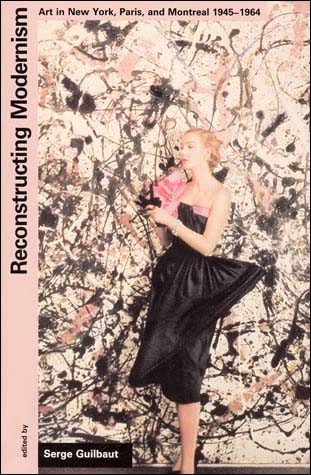Reconstructing Modernism: Art in New York, Paris and Montréal 1945-1964 (1991)
Graham, Robert. (1991). Reconstructing Modernism: Art in New York, Paris and Montréal 1945-1964. Parachute, 62, p. 50. Retrieved from https://numerique.banq.qc.ca/patrimoine/details/52327/3645293
Reconstructing Modernism : Art in New York, Paris, and Montréal 1945-1964, Serge Guilbaut, ed., Cambridge, Massachusetts and London, England : The MIT Press, 1990, 419 pp., illus. b & w.
Serge Guilbaut, author of How New York Stole the Idea of Modern Art (1983) and art historian at The University of British Columbia organized the Hot Paint for Cold War symposium in Vancouver in 1986. An edited version of the given papers and their audience responses constitute Reconstructing Modernism : Art in New York, Paris, and Montréal 1945-1964.
In this book, Guilbaut spatializes art history and develops a geo-aesthetics which gave to location an importance not only as the background source of art but also representing a strategic position in art. The ways in which art and artists are placed and circulated matter. Moreover, in the post-World War II era, the location/ position linkage helps us to follow the conflict over the political con tent of abstraction, and how this issue became a key element in the suborning of art to the Cold War contest.
Guilbaut having initiated play, the eleven other participants follow with different, yet related, approaches. Among the contributors, Jean Baudrillard calls for a thermo-anthropology: an analysis of hot and cold wars, hot and cool media, etc. Timothy J. Clark (dedicating his essay to Guilbaut) inquires into the transformation of Jackson Pollock’s drips into masterworks. Laurie J. Monahan delineates the “Cultural Cartography” of Robert Rauschenberg’s triumph at the 1964 Venice Biennale, while Thierry de Duve gives us a history of those free-floating signifiers – the monochrome and the blank canvas. Mostly materialists, the authors search recent archives to turn up all kinds of revealing forgotten history.
Absent, but influential to the proceedings, is the person of Clement Greenberg. As the dominant critic of the post-War art scene, Greenberg provides for examination a primary account of the period. But more than that, as a formalist sensitive to society, he is the figure so many of these commentators – political and sensitive to form – find necessary to overcome. The “reconstruction” of modernism here does not mean its repudiation as an errant project, but the reclaiming and remoulding of it for the present. R.G.